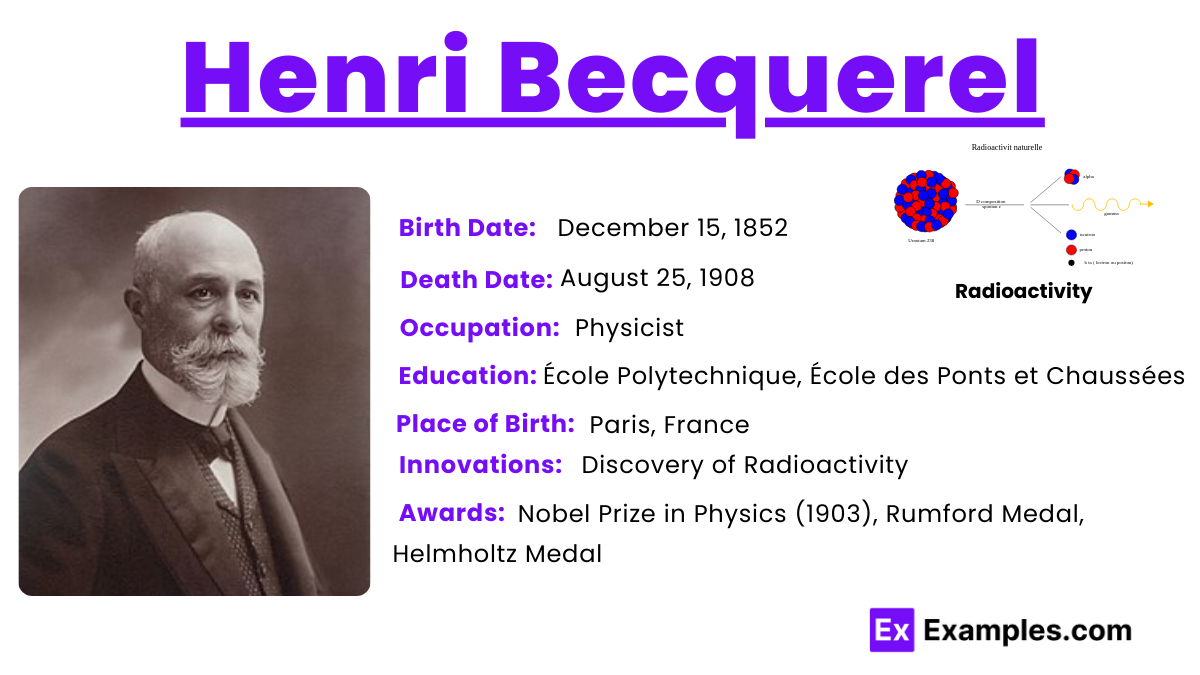Which discovery is Henri Becquerel most renowned for in the field of physics?
X-rays
Radioactivity
Electromagnetism
Quantum mechanics

Henri Becquerel was born into a family with a rich legacy in science, on December 15, 1852, in Paris, France. His father Alexandre-Edmond Becquerel, was an esteemed physicist. And his grandfather, Antoine César Becquerel, had been a pioneering researcher in the field of electrochemistry. Growing up in such an intellectually stimulating environment, Henri was naturally drawn to the sciences from a young age. His family’s influence and access to a wealth of scientific knowledge and resources played a crucial role in shaping his early interest in physics.
Henri’s formal education in physics began at Lycée Louis-le-Grand, a prestigious secondary school in Paris. During his time here, Henri demonstrated exceptional aptitude in mathematics and physics, which were bolstered by his family’s encouragement and academic background. His experiences at this school solidified his foundation in scientific principles and prepared him for advanced studies.
In 1872, Henri Becquerel enrolled at the École Polytechnique, one of France’s leading engineering schools. His education here was marked by rigorous training in the sciences and engineering, which honed his analytical skills and deepened his knowledge of physical phenomena. The school’s emphasis on practical and theoretical aspects of science greatly influenced his approach to research.
After completing his studies at the École Polytechnique. Henri advanced to the École des Ponts et Chaussées, where he focused on civil engineering. This phase of his education introduced him to a more applied aspect of science. He integrated his knowledge of physics with engineering challenges. It was during his time here that he began to develop a keen interest in the properties of natural elements, which would later lead to his experiments with uranium salts and the discovery of radioactivity.
In 1896, Henri Becquerel conducted a series of experiments that led to the groundbreaking discovery of radioactivity. Initially, he was investigating phosphorescence in uranium salts, which he believed might emit X-rays, newly discovered by Wilhelm Roentgen. Becquerel placed photographic plates wrapped in black paper and a piece of uranium salt on top in a drawer. He expecting sunlight to trigger radiation. However, cloudy weather prevented the experiment from proceeding as planned. When he later developed the photographic plates, he found clear images of the uranium crystals, showing that the uranium emitted radiation without any exposure to light. This experiment demonstrated that uranium naturally emits penetrating rays, a phenomenon entirely independent of external energy sources, which he later termed “radioactivity.”
Following his initial discovery, Becquerel continued to explore the properties of the rays emitted by uranium. He conducted experiments to understand how different materials could absorb these rays. Using magnets, he demonstrated that the rays were not deflected by magnetic fields, suggesting they were not electromagnetic in nature like light or X-rays. He also found that the rays could penetrate sheets of metal to varying degrees depending on the metal’s thickness and type. These experiments helped establish the fundamental understanding that radioactive rays have particle-like properties and could pass through solid objects, a key concept in the study of atomic and nuclear physics.
Becquerel further investigated the nature of the rays emitted by uranium by studying their effects on different substances. He found that these rays could darken photographic plates and ionize air, making it conductive. Through these experiments, Becquerel showed that the radiation was capable of altering the chemical and physical properties of materials it interacted with, paving the way for future research into the medical and industrial applications of radioactivity. His meticulous study of these rays contributed significantly to the early understanding of atomic physics and the complex interactions between radiation and matter.
He was passed away on August 25, 1908, in Le Croisic, France. His death, at the age of 55, resulted from complications that were believed to be related to his prolonged exposure to radioactive materials during his experiments. The scientific community mourned the loss of this pioneering physicist who had made significant contributions to understanding radioactivity and its properties.
Henri Becquerel discovered radioactivity. It was notably in uranium salts, laying foundational concepts for nuclear physics and earning the 1903 Nobel Prize in Physics.
He did not propose an atomic theory but demonstrated that atoms might contain internal energy sources, hinting at subatomic structures.
Henri Becquerel’s radioactivity discovery was accidental while studying phosphorescent materials. He was part of a Nobel Prize-winning family lineage in physics.
Text prompt
Add Tone
10 Examples of Public speaking
20 Examples of Gas lighting
Which discovery is Henri Becquerel most renowned for in the field of physics?
X-rays
Radioactivity
Electromagnetism
Quantum mechanics
In which year did Henri Becquerel discover radioactivity?
1895
1896
1897
1898
What type of radiation did Becquerel first observe in his experiments?
Alpha rays
Beta rays
Gamma rays
X-rays
Which element did Henri Becquerel study to discover radioactivity?
Thorium
Uranium
Radium
Polonium
What experimental technique did Becquerel use to discover radioactivity?
Photographic plates
Cathode ray tubes
Spectroscopy
Magnetic resonance imaging
Which award did Henri Becquerel share with Marie and Pierre Curie in 1903?
Nobel Prize in Chemistry
Nobel Prize in Physics
Copley Medal
Lavoisier Medal
What was the main contribution of Henri Becquerel to the study of radiation?
The discovery of X-rays
The identification of gamma rays
The concept of half-life
The discovery of radioactivity
Which of the following did Henri Becquerel's work primarily focus on?
Nuclear fusion
Atomic structure
Spontaneous emission of radiation
Electromagnetic waves
How did Henri Becquerel's discovery of radioactivity influence later scientific research?
It led to the development of quantum mechanics
It contributed to the understanding of atomic nuclei
It resulted in the invention of the electron microscope
It caused the creation of the theory of relativity
Which property of uranium did Becquerel find to be key in his discovery?
Its ability to conduct electricity
Its ability to emit light
Its ability to emit radiation
Its magnetic properties
Before you leave, take our quick quiz to enhance your learning!

